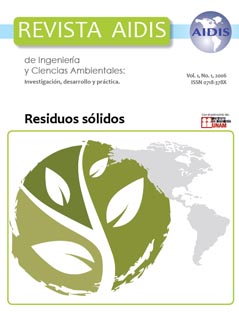Dispersión de materiales aerotransportables viables, en el área de tratamiento y disposición final de residuos sólidos municipales de la Cd. de Mérida, Yucatán
Main Article Content
Abstract
Solid waste managing and disposal systems can contribute to the dispersion of the microorganisms that colonize the waste which is found in diverse states of degradation. The presence and dispersion of bioaerosols from these sites is considered as a potential human health risk for workers and for surrounding communities. The aim of this work was to quantify and to determine the dispersion of bioaerosols, in the area of recycling, composting and disposal of municipal solid waste of the City of Mérida, Yucatán, Mexico. After two preliminary surveys, 20 sampling points were selected, based on dominant wind direction. Samples were collected using a six stages Andersen. Nutritive agar and Dextrose and Potato agar were used for total counts and fungi quantification respectively. Sampling time was 30 seconds and the impactor was placed up to the breathable height (1.50 m). Maximum quantities of CFU/m³ were registered and geometric means were calculated for every sampling site. SURFER 8 software was employed in order to display the results on site. The composting plant had the highest quantification for the general count of bioaerosols and the quantification of fungi. The landfill was the area of highest amount for the bioaerosols quantification during the first sampling. The highest averages for both, bioaerosols and fungi were foud in the composting plant during the second sampling. High percentages of microorganisms distributed in the 4, 5 and 6 strata of the Andersen were found at the points of highest generation of bioaerosols for every evaluated site. This implies the breathing of microorganisms from 2.1 to 0.65 μm of diameter. The presence of bioaerosols in this study site was not overhead the values reported for similar places in other parts of the world. Nevertheless, periodical monitoring is recommended in order to avoid risks to workers of the site.
